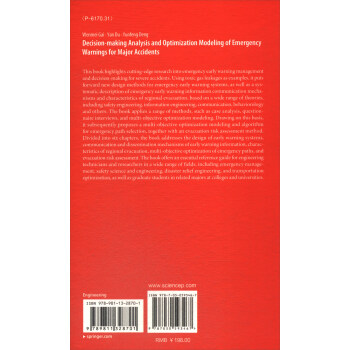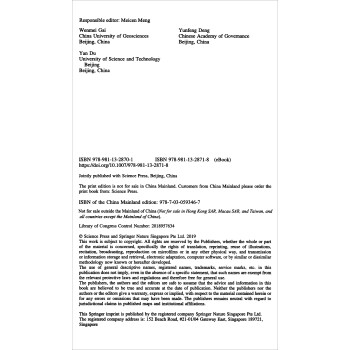内容简介:
《重大事故紧急预警决策的分析和优化模式(英文版)》highlights cutting-edge research into emergency early warning managementand decision-making for severe accidents. Using toxic gas leakages as examples, it putsforward new design methods for emergency early warning systems, as well as a sys-tematic description of emergency early warning information communication mecha-nisms and characteristics of regional evacuation, based on a wide range of theories,including safety engineering, information engineering, communication, behaviorologyand others. The book applies a range of methods, such as case analysis, question-naire interviews, and multi-objective optimization modeling. Drawing on this basis,it subsequently proposes a multi-objective optimization modeling and algorithmfor emergency path selection, together with an evacuation risk assessment method.Divided into six chapters, the book addresses the design of early warning systems,communication and dissemination mechanisms of early warning information, charac-teristics of regional evacuation, multi-objective optimization of emergency paths, andevacuation risk assessment. The book offers an essential reference guide for engineeringtechnicians and researchers in a wide range of fields, including emergency manage-ment, safety science and engineering, disaster relief engineering, and transportationoptimization, as well as graduate students in related majors at colleges and universities.
目录:
1 Introduction
1.1 Background
1.2 What Is Emergency Warning
1.3 Leakage Accidents and Regional Evacuation in China
1.3.1 The Regional Distribution of Toxic Gas Leakage Resulting in Evacuation
1.3.2 Statsfical Analysis of Evacuation Events
1.4 Public Protection Methods
1.4.1 The Basic Process of Emergency Evacuation
1.4.2 Safety Requirement for Personnel Evacuation for Toxic Gas Leakage
1.4.3 Determining Method of Evacuation Area
1.5 Evacuation Scale Estimation
1.5.1 Population Scale Estimation Methods
1.5.2 The Influence Factors on the Scale of Evacuation
1.6 Research Status of Emergency Decisions Both at Home and Abroad
1.7 Research Objects and Characteristics
References
2 Emergency Warning System for Major Accidents
2.1 Emergency Warning System
2.1.1 Composition of the Early Warning System
2.1.2 Functions of Early Warning System
2.1.3 Implementation of Early Warning System
2.2 Literature Review on References of Emergency Early Warning Both at Home and Abroad
2.2.1 Public Alerting System in the United States
2.2.2 The Public Alerting System in Japan
2.2.3 Public Alert System from Other Foreign Organizations
2.2.4 Public Alerting System in China
2.3 The Design and Implementation of Early Warning System for Major Accidents
2.3.1 FM Broadcasting Technology Based on Different Locations
2.3.2 The Structure of Public Alert System Based on FM Broadcast for Different Addresses
2.3.3 Researches on Hardware Development of Indoor Alarm Receivers
2.3.4 Researches on Embedded Software Development of Indoor Alarm Receivers
2.4 Summary of the Chapter
References
3 Communication and Diffusion of Emergency Warning
3.1 An Overview of Researches on Communication and Diffusion of Emergency Warning
3.2 The Influence Factors of Early Warning Communication
3.3 General Rules for Alert Information Communication
3.4 Modeling of the Communication Rules of Alert for Individual Household
3.4.1 The Establishment of the Model
3.4.2 The Solution of the Model
3.5 The Simulation and Results Analysis of Communication Model of Alerts for Individual Household
3.5.1 Simulation Results and Analysis of the Communication Time
3.5.2 The Simulation Results and Analysis of Closeness of Social Relationship
3.5.3 Simulation Analysis and Results of Deployment Proportion of Alert Receivers
3.6 Summary of the Chapter
References
4 Regional Evacuation Modeling for Toxic Cloud Releases and Its Application in Strategy Assessment of Evacuation Warning
4.1 Methods
4.1.1 Description of Regional Evacuation Network
4.1.2 Diffusion of Evacuation Warning
4.1.3 Loading of Evacuation Flow
4.1.4 Movement Through Regional Evacuation Network
4.2 Health Consequence Analysis
4.2.1 Accident Consequence Simulation
4.2.2 Exposure Dose Calculation
4.2.3 Conditional Probability of Consequences
4.3 Case Study and Discussion in China
4.3.1 Preliminaries
4.3.2 Evacuation Efficiency Under Different Evacuation Warning Strategies
4.3.3 Health Consequences of Accidents Under Different Evacuation Warning Strategies
4.4 Summary of the Chapter
References
5 Multi-objective Route Planning Model and Algorithm for Emergency Management
5.1 Literature Review
5.2 Route Planning Model for Emergency Logistics Management
5.2.1 Definition of Variables and Parameters
5.2.2 Bounded Rationality in Decision-Making
5.2.3 Multi-objective Route Planning Model for Emergency Logistics Management
5.3 Preliminaries
5.3.1 Classical Algorithms to Solve Single-Objective Shortest Path Problem
5.3.2 Construction of Auxiliary Functions
5.3.3 Main-Objective Method to Deal with Multi-objective Optimization Problems
5.4 Proposed Heuristic Algorithm
5.4.1 Static Heuristic Algorithm to Solve Model I Based on A* Algorithm
5.4.2 Dynamic Heuristic Algorithm to Solve Model I Based on D* Algorithm
5.4.3 Algorithm Advantage
5.5 Computational Experiments
5.5.1 Results of Model IH When T Varies Within the Interval [0, 1
5.5.2 Results of Model I in Static Environments
5.5.3 Results of Model I in Dynamic Environments
5.6 Summary of the Chapter
References
6 Evacuation Risk Assessment of Regional Evacuation for Major Accidents and Its Application in Emergency Planning
6.1 Evacuation Risk Assessment Process
6.1.1 Calculation of Received Dose
6.1.2 Conditional Probability Calculation of Health Consequence
6.1.3 Determination of Occurrence Probability
6.1.4 Calculation of Individual Evacuation Risk
6.1.5 Acceptable Risk Level
6.2 The Application in Emergency Planning
6.2.1 The Application in Emergency Preparation
6.2.2 Division of Risk Areas
6.2.3 Emergency Preparation in Each Area
6.3 The Application in Emergency Response
6.4 Summary of the Chapter
References





好评度